Search results for: 'bronzezeit'
-
 Egyptian cowroid with protective function
Egyptian cowroid with protective functionAmulet seal with pseudo hieroglyphs at the underside that should give protection or good luck to the owner according to ancient Egyptian beliefs. Second Intermediate Period of ancient Egypt.
Price: on request Early flat axe from Judea
Early flat axe from JudeaInteresting bronze axe head from Early Bronze Age. The piece was found in Judea.
Price: on request Early flat axe from Judea
Early flat axe from JudeaCompact bronze axe head from Early Bronze Age. The piece was found in Judea.
Price: on request Syrian amulet in animal shape
Syrian amulet in animal shapeSmall amulet of nice red stone in the stylized shape of a pig. From the 3rd Millenium BC.
Price: on request Western Asiatic macehead
Western Asiatic maceheadHeavy stone head of a mace with a depressed globular shape. Beautiful whitish brown hardstone. From the Early Bronze Age of Western Asia.
Price: on request Egyptian hippopotamus amulet
Egyptian hippopotamus amuletMade in the style of a scarab but with a hippopotamus on the upper side. It was a protective amulet during the 18th or 19th dynasty of Ancient Egypt. It might have protected a pregnant woman. The amulet comes from the famous Matouk collection and is published in his 1971 book.
Price: on request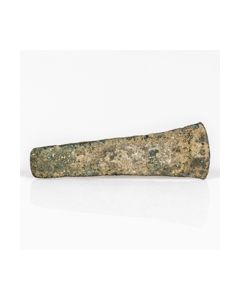 Early flat axe from Judea
Early flat axe from JudeaTrapezoidal axe head from Early Bronze Age. The piece was found in Judea.
Price: on request Western Asiatic macehead
Western Asiatic maceheadHeavy head of a mace with an ovoid shape. Wonderful veined rock. From Early Bronze Age of the Near East.
€830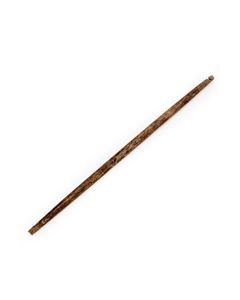 Egyptian spindle shaft made of wood
Egyptian spindle shaft made of woodExceptionally rare main piece of a hand spindle. A find from Thebes in Upper Egypt. From the reign of pharao Senusret II, around 1840 BC.
Price: on request Egyptian cowroid
Egyptian cowroidAmulet seal with pseudo hieroglyphs at the underside. Second Intermediate Period of ancient Egypt.
Price: on request Small Mycenaean amphora
Small Mycenaean amphoraElegant vessel with three handles and painting. From the Mycenaean Age around 1300 BC.
Price: on request Egyptian cowroid with knot design
Egyptian cowroid with knot designAmulet seal with interesting design at the underside that might represent the unity of Egypt. Second Intermediate Period of ancient Egypt.
Price: on request Western Asiatic macehead
Western Asiatic maceheadHeavy head of a mace with a globular shape. Nicely polished stone. From the Early Bronze Age of Western Asia.
€670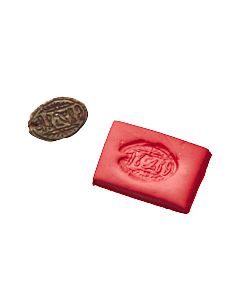 Egyptian cowroid with nice decoration
Egyptian cowroid with nice decorationAmulet seal with pseudo hieroglyphs at the underside that should give protection or good fortune to the owner according to ancient Egyptian beliefs. New Kingdom of ancient Egypt.
Price: on request Egyptian funerary cone of Amunemopet
Egyptian funerary cone of AmunemopetConoid clay nail from the tomb of crown prince Amunemopet. From Thebes during the 18th dynasty. New Kingdom of ancient Egypt.
Price: on request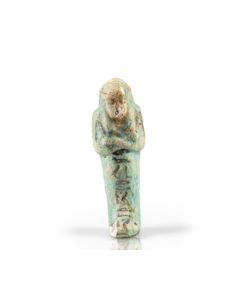 Ushabti for Bu-iri-eri-Renenutet
Ushabti for Bu-iri-eri-RenenutetEgyptian funerary figurine from the Third Intermediate Period. The owner's name is rarely attested and could hint to an origin in the Faiyum Oasis.
Price: on request Two Mesopotamian mosaic cones
Two Mesopotamian mosaic conesThe pieces were part of a mosaic decoration of a Mesopotamian structure in the 4th Millenium BC. The temple architecture from Uruk is a particularly well known example of such a use.
Price: on request Cylinder seal from the Jemdet Nasr period
Cylinder seal from the Jemdet Nasr periodThe Mesopotamian seal shows a geometrical arrangement of schematic turtles or tadpoles. Around 3000 BC.
€660 Sumerian foundation cone from Uruk
Sumerian foundation cone from UrukSmall conoid clay nail with cuneiform inscription. From the main temple of Uruk, that is also mentioned in the Epos of Gilgamesh. Circa 3rd Millenium BC.
Price: on request Mesopotamian cuneiform tablet
Mesopotamian cuneiform tabletSmall clay tablet with well preserved Sumerian cuneiform writing. From Mesopotamia, probably from Uruk.
Price: on request Clay ushabti
Clay ushabtiTall Egyptian funerary statuette from the New Kingdom. From the collection of the archaeologist and artist Erich Charlier.
Price: on request Canaanite bronze blade from General Moshe Dayan collection
Canaanite bronze blade from General Moshe Dayan collectionHoly Land, 3rd - 2nd millennium BC. Exhibited in the Jewish Museum in New York City in 1975. Moshe Dayan was a famous Israeli politician and military leader who served as Chief of Staff of the Israeli Defense Forces, personally commanded the Israeli forces during the 1956 Suez Crisis and served as Defense Minister.
Price: on request Cylinder seal with goddess and humans
Cylinder seal with goddess and humansThe lovely seal made of black hematite is from Middle Bronze Age Anatolia or Syria. It is from the famous Erlenmeyer collection, built in the 1940ies to 1960ies.
Price: on request Old Assyrian cylinder seal
Old Assyrian cylinder sealThe seal shows several gods in front of the god of the heaven. The piece comes from Anatolia or northern Syria, quite possibly from Cappadocia.
€1,150 Gold earrings in the shape of a reed boat
Gold earrings in the shape of a reed boatMatching pair of Late Bronze Age jewellery made of massive gold in the Eastern Mediterranean. The shape is reminiscent of boats made of budles of reed.
Price: on request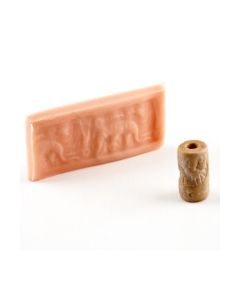 Cylinder seal from early dynastic Mesopotamia
Cylinder seal from early dynastic MesopotamiaDas frühdynastische Rollsiegel aus Mesopotamien zeigt eine Szene mit zwei Personen im Boot, eine davor stehende mit Stab. Es ist aus schönem karamellfarbenem Stein geschnitten. Mitte 3. Jt. v. Chr.
Price: on request Late Bronze age cylinder seal
Late Bronze age cylinder sealLevantinisches Zylindersiegel aus schwarzem Stein. 2. Jt. v. Chr., vermutlich Spätbronzezeit. 16mm lang.
Price: on request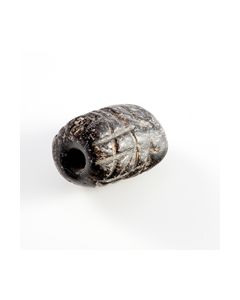 Levantine calinder seal
Levantine calinder sealVorderasiatisches Zylindersiegel aus schwarzem Stein mit geometrischem Motiv. Ca. 17mm lang. Spätbronzezeit.
Price: on request Bronze axe head from Luristan
Bronze axe head from LuristanVotivaxt oder eine Grabbeigabe mit symbolischer Funktion. Vermutlich aus Luristan. Mitte 3. - 2. Jt. v. Chr. Sehr guter Zustand, stabile Bronze mit kräftiger Patina.
Price: on request Bronze blade of a knife dagger from an old German collection
Bronze blade of a knife dagger from an old German collectionVermutlich Dolchklinge aus dem Nahen Osten. 160mm lang, 31mm breit. Etwa 2. Jt. v. Chr. Aus einer alten deutschen Sammlung.
Price: on request Bronze Age chisel
Bronze Age chiselMeißel aus Bronze mit charakteristischen Randleisten. Länglicher, schlanker Körper mit geschwungenen Seiten. Gefunden in Ringwood, Hampshire, Großbritannien.
Price: on request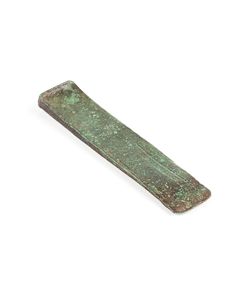 Bronze Age chisel
Bronze Age chiselLänglicher, flacher Körper mit geraden Seiten. Ca. 2 Jt. v. Chr., Bronzezeit. Sehr gute Erhaltung, vermutlich ein Fund aus Großbritannien.
Price: on request Early bronze age mesopotamian cylinder seal
Early bronze age mesopotamian cylinder sealDas vermutlich sumerische Rollsiegel aus schönem schwarzen Stein trägt ein geometrisches Muster als Motiv. Es stammt aus der Uruk- bis Djemdet Nasr-Zeit, 4. bis frühes 3. Jt. v. Chr.
Price: on request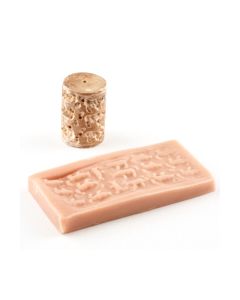 Sumerisches Rollsiegel - Segen der Herden
Sumerisches Rollsiegel - Segen der HerdenSzene mit Herde in Stallung, vermutlich Darstellung göttlichen Segens. Ein Vergleichsfund aus Farah befindet sich im Vorderasiatischen Museum Berlin. 4. bis frühes 3. Jt. v. Chr.
Price: on request Großes Skarabäussiegel aus der Zeit des Amenophis III.
Großes Skarabäussiegel aus der Zeit des Amenophis III.14. Jh. v. Chr. Heute noch erhaltene Überreste der Bautätigkeit Amenophis III. sind die Memnonkolosse, sowie der Hauptteil des Luxor-Tempels.
Price: on request Skarabäussiegel mit abstaktem Stempelmotiv
Skarabäussiegel mit abstaktem StempelmotivDie Stempelfläche trägt ein dekoratives Muster mit ästhetischer oder magischer Funktion. Sehr schöner und anschaulicher Skarabäus, in etwa aus der Zweiten Zwischenzeit des Alten Ägyptens. 2000 bis 1300 v. Chr.
Price: on request

